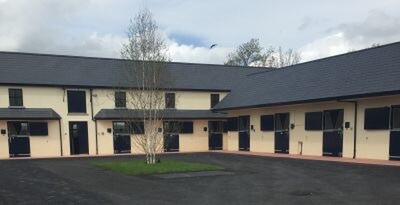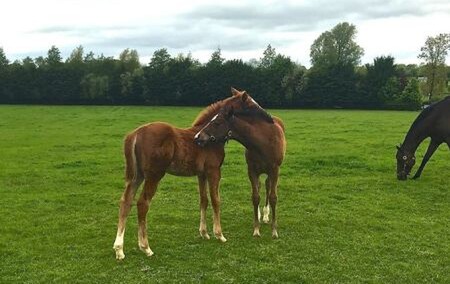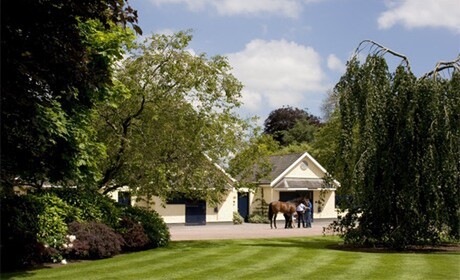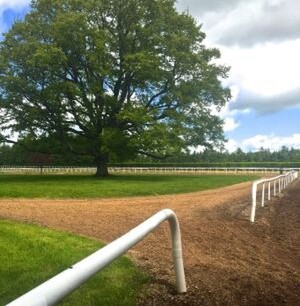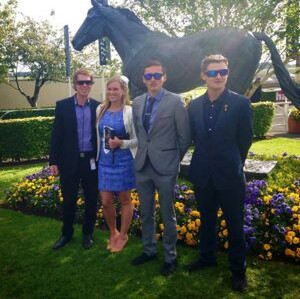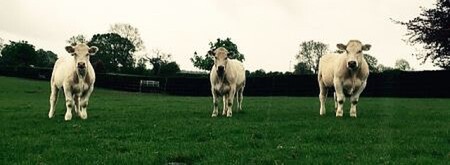COOLMORE STUD, IRELAND
Prospect Foaling Yard
After arriving at Coolmore Stud I started my placement at Prospect foaling yard. Since it was getting late in the season there were only 24 mares left to foal I had not long been in the house when I got the call from Mick the yard manager at around 10.30 pm asking if I would like to see a foaling.
The foaling procedure was very similar to that at Cheveley Park, the mares foal inside on a big box of straw and assisted. When the mare breaks water the presentation of the foal is checked when the manager is happy the mare proceeds on in her own time. The mare will then get comfortable and starting to push we will then slowly move in to the foal and apply small amounts of pressure on the foal the same time the mare pushes.
When the foal has safely arrived, the mare is encouraged to stay sitting down with a small bucket of feed and the foal is also checked to make sure everything is fine. When the mare gets up the after birth is tied up off the ground so the mare won't stand on it and the mare's milk is checked for quality. Then the foal is given an enema and their navel is sprayed with iodine to prevent infection.
After a good hour or so, the foal should not be too far from standing and really looking for a drink. In the morning the foals are checked by the vet and an identification sheet is done on the foal ensuring that every marking and whorl is recorded, they also get a microchip for identification purposes.After three days the mare and new born foal is moved to one of the yards around the farm.
The box is then completely mucked out down to the ground and power washed.The sides of the foaling box are rubber with concrete floors. They are then bedded down with fresh straw ready for the next mare that is due to foal. In the five days I was at the foaling unit there were 10 foals, they were popping out everywhere, I couldn't believe how many foaled in a short amount of time!
Prospect Foaling Yard
After arriving at Coolmore Stud I started my placement at Prospect foaling yard. Since it was getting late in the season there were only 24 mares left to foal I had not long been in the house when I got the call from Mick the yard manager at around 10.30 pm asking if I would like to see a foaling.
The foaling procedure was very similar to that at Cheveley Park, the mares foal inside on a big box of straw and assisted. When the mare breaks water the presentation of the foal is checked when the manager is happy the mare proceeds on in her own time. The mare will then get comfortable and starting to push we will then slowly move in to the foal and apply small amounts of pressure on the foal the same time the mare pushes.
When the foal has safely arrived, the mare is encouraged to stay sitting down with a small bucket of feed and the foal is also checked to make sure everything is fine. When the mare gets up the after birth is tied up off the ground so the mare won't stand on it and the mare's milk is checked for quality. Then the foal is given an enema and their navel is sprayed with iodine to prevent infection.
After a good hour or so, the foal should not be too far from standing and really looking for a drink. In the morning the foals are checked by the vet and an identification sheet is done on the foal ensuring that every marking and whorl is recorded, they also get a microchip for identification purposes.After three days the mare and new born foal is moved to one of the yards around the farm.
The box is then completely mucked out down to the ground and power washed.The sides of the foaling box are rubber with concrete floors. They are then bedded down with fresh straw ready for the next mare that is due to foal. In the five days I was at the foaling unit there were 10 foals, they were popping out everywhere, I couldn't believe how many foaled in a short amount of time!
Guiry 1 : Mare and Foal Barn
I was then moved over to Guiry 1 (Guiry was the family name of the original owner of the property before Coolmore purchased it, and they have continued to name farms after their previous owners)I was amazed at the quality of mares that were in the barn, for example one of my favourite race fillies in her time was Sea Siren, she has a stunning Galileo filly at foot and Melito also champion NSW Horse of the Year has another cracking Galileo filly foal at foot, and Home Coming Queen 1000 Guineas winner; these are just some of the amazing mares that board here.
A general day in Guiry 1 starts around 7:30 am by bringing all the mares and foals in that have been living out at night. They come in to their boxes where their breakfast is waiting for them. The foals are caught at the gate and lead in next to their mothers off the head collar, this teaches the foal to walk and lead. It is so much easier teaching a baby foal than waiting to teach foals at two months.I found the foals to be so much quieter and well handled, it really makes life easier with the day to day care.
Then the vet and farrier will come around and attend to anything that needs to be look at. Around 11am the mares and foals are then turned back out in their paddocks where they will stay out until the following morning.
The boxes are then mucked out and given fresh straw, the barn is tidied up and the stocks (crush) is washed out, after lunch we then go around and give any treatments that any of the horses are on and also check the mares and foals. The only mares that will be coming in at night would be the mares with new young foals. They would usually be around a good month old before they live out permanently.
We then feed the boxed mares a mixture of sweet feed, nuts, oats and a touch of oil - the mares look sensational. Finally, we will then tidy the barn and finish the day.
I was then moved over to Guiry 1 (Guiry was the family name of the original owner of the property before Coolmore purchased it, and they have continued to name farms after their previous owners)I was amazed at the quality of mares that were in the barn, for example one of my favourite race fillies in her time was Sea Siren, she has a stunning Galileo filly at foot and Melito also champion NSW Horse of the Year has another cracking Galileo filly foal at foot, and Home Coming Queen 1000 Guineas winner; these are just some of the amazing mares that board here.
A general day in Guiry 1 starts around 7:30 am by bringing all the mares and foals in that have been living out at night. They come in to their boxes where their breakfast is waiting for them. The foals are caught at the gate and lead in next to their mothers off the head collar, this teaches the foal to walk and lead. It is so much easier teaching a baby foal than waiting to teach foals at two months.I found the foals to be so much quieter and well handled, it really makes life easier with the day to day care.
Then the vet and farrier will come around and attend to anything that needs to be look at. Around 11am the mares and foals are then turned back out in their paddocks where they will stay out until the following morning.
The boxes are then mucked out and given fresh straw, the barn is tidied up and the stocks (crush) is washed out, after lunch we then go around and give any treatments that any of the horses are on and also check the mares and foals. The only mares that will be coming in at night would be the mares with new young foals. They would usually be around a good month old before they live out permanently.
We then feed the boxed mares a mixture of sweet feed, nuts, oats and a touch of oil - the mares look sensational. Finally, we will then tidy the barn and finish the day.
Coolmore Stallions
Coolmore Stud has a world-class line up of stallions including Galileo who is the best in the world, and one of the all time greats.Like his sire Sadler's Wells, he too is now leaving a legacy behind him with multiple Group One performers every year and many colts have gone on to stand at stud.
There are also very nice younger horses coming through with my personal favourite being Camelot. He is by the Champion sire Montjeu, Camelot has cracking first crop foals here in Ireland and has every chance to succeed.
I was really pleased to get the opportunity to spend time working with the stallions. The working day starts out at the covering barn, every mare is initially jumped by the teaser and then tail is wrapped. She is washed up. Every mare is checked to make sure she is the correct mare for the stallion, and especially so for walk in mares. For a walk in breeding, the client will head in to the waiting room for a tea and coffee! There is a TV monitor were they can watch their mare being covered.
Every cover is recorded for security and insurance purposes. The mare is then sent up to one of two covering areas, the covering shed is a fully padded circled shed with an all-weather rubber mix base. The mare gets padded leather boots on her hind feet so in the unlikely event of the mare kicking out the stallion won't get injured. If she has a foal at foot, the foal will be put in a safe fenced area near to where the mare will be standing. She is then twitched by the upper lip. The stallion will enter the shed, there is one of the managers holding the mare's tail and one person holding the mare both standing on the off side. There is also one of the senior stud managers attending all the breedings.
When the stallion is ready he will mount the mare, the manager holding the mare's tail will take the pulse of the stallion to make sure the job is done. When the stallion dismounts the mare's head is pulled towards the stallion, by doing this it will prevent the mare from being able to kick, since her rear end will be turning away from the stallion. The boots and twitch are taken off and the mare is given back to her owner who will have her scanned in 15 days time.
Coolmore Stud has a world-class line up of stallions including Galileo who is the best in the world, and one of the all time greats.Like his sire Sadler's Wells, he too is now leaving a legacy behind him with multiple Group One performers every year and many colts have gone on to stand at stud.
There are also very nice younger horses coming through with my personal favourite being Camelot. He is by the Champion sire Montjeu, Camelot has cracking first crop foals here in Ireland and has every chance to succeed.
I was really pleased to get the opportunity to spend time working with the stallions. The working day starts out at the covering barn, every mare is initially jumped by the teaser and then tail is wrapped. She is washed up. Every mare is checked to make sure she is the correct mare for the stallion, and especially so for walk in mares. For a walk in breeding, the client will head in to the waiting room for a tea and coffee! There is a TV monitor were they can watch their mare being covered.
Every cover is recorded for security and insurance purposes. The mare is then sent up to one of two covering areas, the covering shed is a fully padded circled shed with an all-weather rubber mix base. The mare gets padded leather boots on her hind feet so in the unlikely event of the mare kicking out the stallion won't get injured. If she has a foal at foot, the foal will be put in a safe fenced area near to where the mare will be standing. She is then twitched by the upper lip. The stallion will enter the shed, there is one of the managers holding the mare's tail and one person holding the mare both standing on the off side. There is also one of the senior stud managers attending all the breedings.
When the stallion is ready he will mount the mare, the manager holding the mare's tail will take the pulse of the stallion to make sure the job is done. When the stallion dismounts the mare's head is pulled towards the stallion, by doing this it will prevent the mare from being able to kick, since her rear end will be turning away from the stallion. The boots and twitch are taken off and the mare is given back to her owner who will have her scanned in 15 days time.
Ballydoyle Training Yard, Tipperary
After my time with the stallions I was given an amazing opportunity to spend time in the most successful and famous training facilities in the world. Under the watchful eye of Aidan O'Brien. Ballydoyle has produced some of the greatest racehorses in the world for both Aidan O'Brien and his predecessor, Master trainer Vincent O'Brien. My first day I was put in to the main new yard where three-year-old and older colts are kept. The horses that are in the yard are truly amazing and very talented and include the likes of top three-year-old and dual Group 1 winner Gleneagles.
The morning starts at 6.30 am with the horses getting ready for exercise, the jockeys will then come in and tack up their horse with every horse having its own individual and specialized tack. The jockeys will then get on and walk them in a giant indoor arena for 20 minutes and trot for five, when the horses are well warmed up and Aidan is happy with them they will then go out on to the gallops.
Every horse has a different program depending on if they have a race coming up or if they have just had a race. The gallops are truly amazing, one is wood chip with a good gradual pull, there is an all-weather gallop and a grass gallop with a replica of the corner of Epsom. Also one of the things that helps to the success is the quality of staff and the riders that are employed to work at Ballydoyle. They come from a variety of different countries and many have been there for a long time.
After my time with the stallions I was given an amazing opportunity to spend time in the most successful and famous training facilities in the world. Under the watchful eye of Aidan O'Brien. Ballydoyle has produced some of the greatest racehorses in the world for both Aidan O'Brien and his predecessor, Master trainer Vincent O'Brien. My first day I was put in to the main new yard where three-year-old and older colts are kept. The horses that are in the yard are truly amazing and very talented and include the likes of top three-year-old and dual Group 1 winner Gleneagles.
The morning starts at 6.30 am with the horses getting ready for exercise, the jockeys will then come in and tack up their horse with every horse having its own individual and specialized tack. The jockeys will then get on and walk them in a giant indoor arena for 20 minutes and trot for five, when the horses are well warmed up and Aidan is happy with them they will then go out on to the gallops.
Every horse has a different program depending on if they have a race coming up or if they have just had a race. The gallops are truly amazing, one is wood chip with a good gradual pull, there is an all-weather gallop and a grass gallop with a replica of the corner of Epsom. Also one of the things that helps to the success is the quality of staff and the riders that are employed to work at Ballydoyle. They come from a variety of different countries and many have been there for a long time.
The horses that are running overseas are flown in and out on the same day after the race. It really takes out all the potential stress and gives the horse the best chance to perform at his best on the day. Some trips, for example the runners in France, would usually take a few days for the horses to get there and back, now can be all done on the same day.
At the moment I am continuing my placement time at Ballydoyle and enjoying and absorbing all of this once in a lifetime opportunity.
In my first two weeks in Ireland, I was very lucky to have been given tickets by Coolmore Stud to go to the 2000 Guineas and 1000 Guineas at the Curragh.
Interesting fact: The name "Curragh" comes from Irish (Gaeilge) word Cuirreach, meaning "place of the running horse". The first recorded race on the plain took place in 1727, but it was used for races before then. The first Derby was held in 1866, and in 1868 the Curragh was officially declared a horse racing and training facility by act of parliament.
On the Saturday the Irish 2000 Guineas was won by the Aidan O'Brien-trained and Coolmore Stud owned Gleneagles, making it a Anglo-Irish 2000 Guiness double having already won the Guineas in England at Newmarket three weeks earlier. Gleneagles is now heading for Ascot. Gleneagles is by Champion sire Galileo.
At the moment I am continuing my placement time at Ballydoyle and enjoying and absorbing all of this once in a lifetime opportunity.
In my first two weeks in Ireland, I was very lucky to have been given tickets by Coolmore Stud to go to the 2000 Guineas and 1000 Guineas at the Curragh.
Interesting fact: The name "Curragh" comes from Irish (Gaeilge) word Cuirreach, meaning "place of the running horse". The first recorded race on the plain took place in 1727, but it was used for races before then. The first Derby was held in 1866, and in 1868 the Curragh was officially declared a horse racing and training facility by act of parliament.
On the Saturday the Irish 2000 Guineas was won by the Aidan O'Brien-trained and Coolmore Stud owned Gleneagles, making it a Anglo-Irish 2000 Guiness double having already won the Guineas in England at Newmarket three weeks earlier. Gleneagles is now heading for Ascot. Gleneagles is by Champion sire Galileo.
The 1000 Guineas winner Pleascach by Teofilo was trained and bred by Jim Bolger which is an amazing achievement. Also on the Sunday was the Tattersalls Gold Cup Group 1, always a good race, So You Think won it twice and we also witnessed another double Al Kazeem by Dubawi winning it for a second time making his return back to racing from stud!
All in all it was a great weekends racing up at the Curragh, the sun was out and great crowds both days it was also a good opportunity to catch up with a few friends I hadn't seen in couple of years.
In addition to the horses Coolmore Stud farm around 1600 Charolais cattle. They are housed in big barns around the stud over the hard winters and then put out on the pasture in the spring. They are all steers and top of the line beasts, with almost every paddock having around five Charolais cattle in each and since they are all the same colour they inter mix well with the horses.
All in all it was a great weekends racing up at the Curragh, the sun was out and great crowds both days it was also a good opportunity to catch up with a few friends I hadn't seen in couple of years.
In addition to the horses Coolmore Stud farm around 1600 Charolais cattle. They are housed in big barns around the stud over the hard winters and then put out on the pasture in the spring. They are all steers and top of the line beasts, with almost every paddock having around five Charolais cattle in each and since they are all the same colour they inter mix well with the horses.
I am really enjoying my time in Ireland, and I have just one month left before heading to Taylor Made Farm in Kentucky America. I have learnt so much and now understand and appreciate the true quality and attention to detail, that Coolmore put in to everything they do.
Ballydoyle has been an amazing experience for me too since I have had very little experience with racehorses. I have found it very interesting, especially with the variation of training from country to country. Here there is a lot of morning work on the gallops, but also with the variety of a lot of walking as part of their fitness regime work. This is in comparison to a majority of New Zealand and Australian trainers just working horses on the training tracks alone.
This for me is the most interesting thing I have seen to date over the period of my travels, the horses are really trained for fitness and stamina since the style of racing is completely different. Some of the race tracks here are like roller coasters; very up and down, with some having quite a lot of incline, whereas the Australasian tracks are mostly flat. We have a very big week ahead with Royal Ascot coming up and a good few horses racing over that week.
Ballydoyle has been an amazing experience for me too since I have had very little experience with racehorses. I have found it very interesting, especially with the variation of training from country to country. Here there is a lot of morning work on the gallops, but also with the variety of a lot of walking as part of their fitness regime work. This is in comparison to a majority of New Zealand and Australian trainers just working horses on the training tracks alone.
This for me is the most interesting thing I have seen to date over the period of my travels, the horses are really trained for fitness and stamina since the style of racing is completely different. Some of the race tracks here are like roller coasters; very up and down, with some having quite a lot of incline, whereas the Australasian tracks are mostly flat. We have a very big week ahead with Royal Ascot coming up and a good few horses racing over that week.
